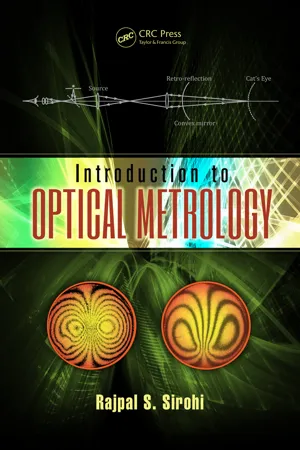
eBook - ePub
Introduction to Optical Metrology
Rajpal S. Sirohi
This is a test
Share book
- 449 pages
- English
- ePUB (mobile friendly)
- Available on iOS & Android
eBook - ePub
Introduction to Optical Metrology
Rajpal S. Sirohi
Book details
Book preview
Table of contents
Citations
About This Book
Introduction to Optical Metrology examines the theory and practice of various measurement methodologies utilizing the wave nature of light. The book begins by introducing the subject of optics, and then addresses the propagation of laser beams through free space and optical systems. After explaining how a Gaussian beam propagates, how to set up a collimator to get a collimated beam for experimentation, and how to detect and record optical signals, the text:
- Discusses interferometry, speckle metrology, moiré phenomenon, photoelasticity, and microscopy
- Describes the different principles used to measure the refractive indices of solids, liquids, and gases
- Presents methods for measuring curvature, focal length, angle, thickness, velocity, pressure, and length
- Details techniques for optical testing as well as for making fiber optic- and MEMS-based measurements
- Depicts a wave propagating in the positive z-direction by e i(?t – kz), as opposed to e i(kz – ?t)
Featuring exercise problems at the end of each chapter, Introduction to Optical Metrology provides an applied understanding of essential optical measurement concepts, techniques, and procedures.
Frequently asked questions
How do I cancel my subscription?
Can/how do I download books?
At the moment all of our mobile-responsive ePub books are available to download via the app. Most of our PDFs are also available to download and we're working on making the final remaining ones downloadable now. Learn more here.
What is the difference between the pricing plans?
Both plans give you full access to the library and all of Perlego’s features. The only differences are the price and subscription period: With the annual plan you’ll save around 30% compared to 12 months on the monthly plan.
What is Perlego?
We are an online textbook subscription service, where you can get access to an entire online library for less than the price of a single book per month. With over 1 million books across 1000+ topics, we’ve got you covered! Learn more here.
Do you support text-to-speech?
Look out for the read-aloud symbol on your next book to see if you can listen to it. The read-aloud tool reads text aloud for you, highlighting the text as it is being read. You can pause it, speed it up and slow it down. Learn more here.
Is Introduction to Optical Metrology an online PDF/ePUB?
Yes, you can access Introduction to Optical Metrology by Rajpal S. Sirohi in PDF and/or ePUB format, as well as other popular books in Technology & Engineering & Electrical Engineering & Telecommunications. We have over one million books available in our catalogue for you to explore.
Information
1 | Introduction to Optics |
1.1 INTRODUCTION
Metrology is the science and technology of making measurements and drawing significant conclusions from a set of data. Optical metrology uses light-based techniques for measurement. The majority of measurements involve length in one form or other and hence most of the techniques reported in this book will relate to length measurement. Besides, there are some physical parameters of direct relevance in optics and hence the techniques of measurement of these parameters will also be included in the text.
Length is expressed in meters. Prior to 1889, the meter was defined as 1/10,000,000 the distance between the North Pole and the equator along the line of longitude passing through Paris, France. A platinum bar of length equal to the meridional definition of the meter was to be the prototype meter (end standard). The end standard meter was found impracticable due to wear of the ends to ensure international reproducibility and hence was replaced by the line standard. The standard meter is defined as a length between two fine lines engraved on a platinum-iridium bar of an X cross section maintained and measured under very accurately controlled conditions. It remained in force from 1889 to 1960. However, because of the everpresent threat of natural disaster damaging the physical artifact, the standard based on the platinum-iridium bar was replaced by a standard based on the wavelength of light. The length of 1,650,763.73 times the wavelength of the orange-red line in the emission spectrum of 86Kr was accepted as a standard meter; this definition remained in force from 1960 to 1984.
During this period, several other laser sources became the contenders for the length standard. In 1983, the 17th Ge...